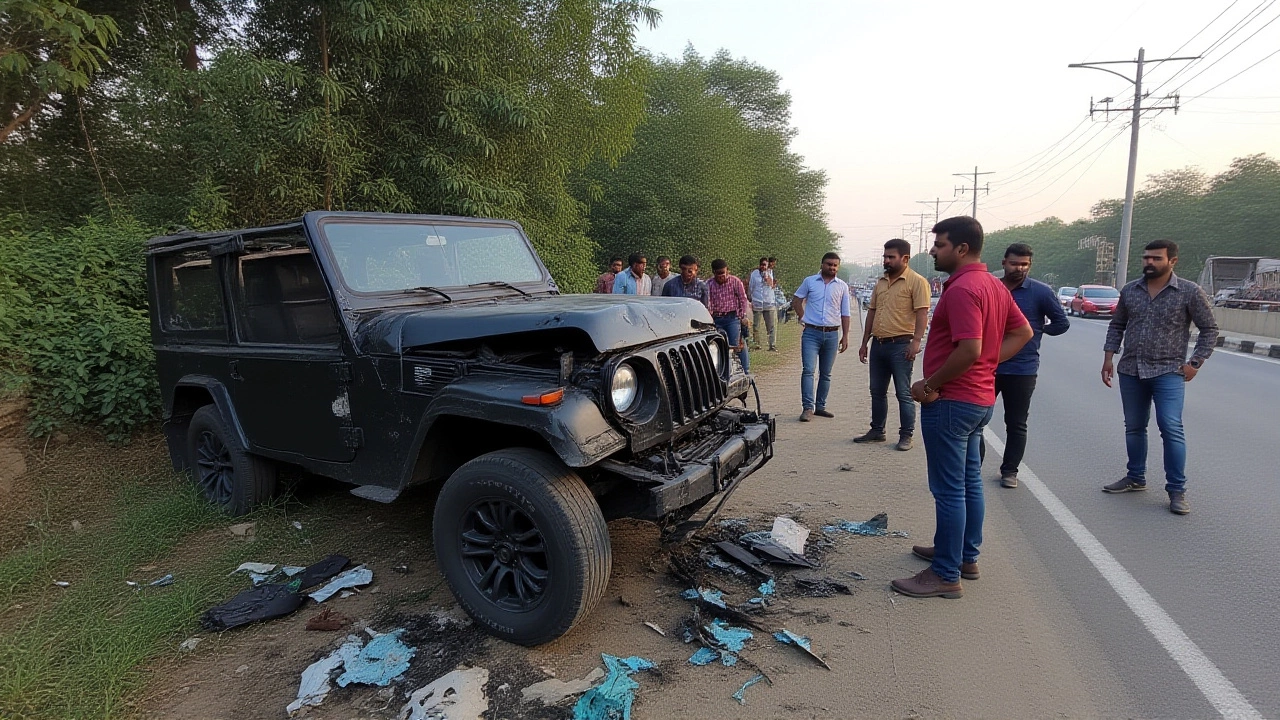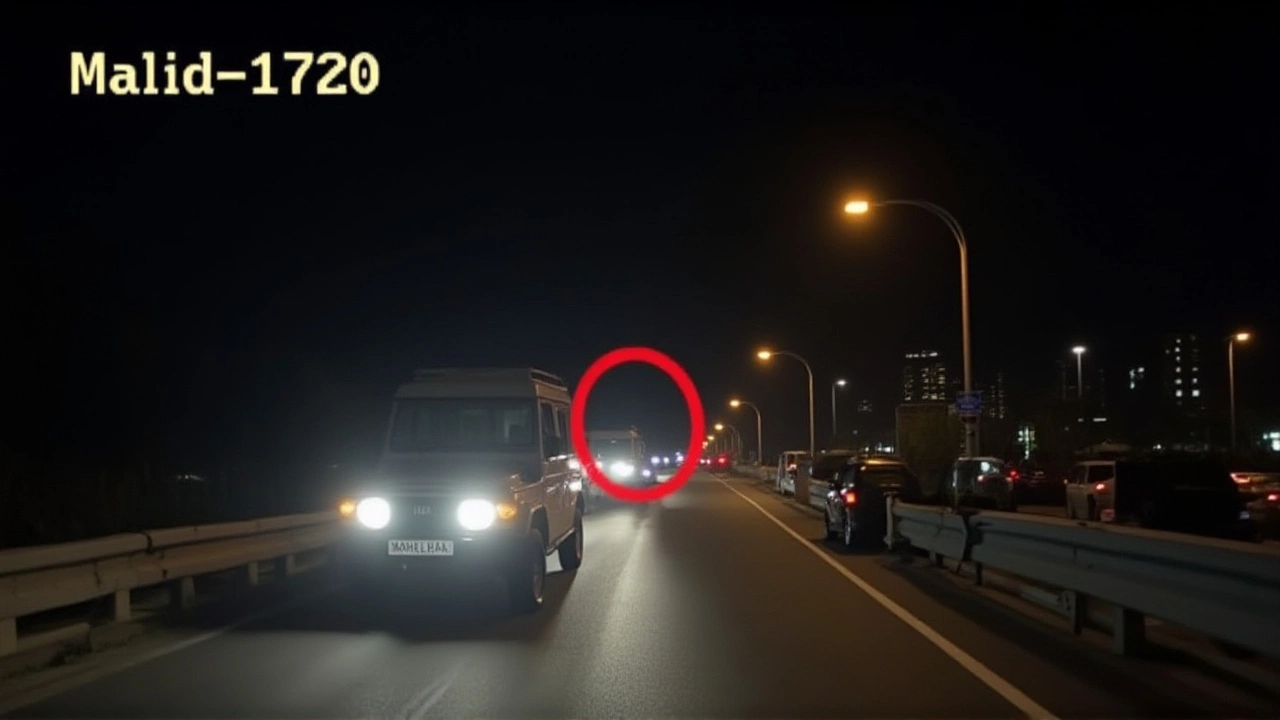Five Dead, One Critical in Gurgaon Thar Crash After Hitting Divider at 100 km/h

When Kapil Sharma, a 27‑year‑old driver of a black Mahindra Thar lost control at roughly 100 km/h and slammed into a concrete divider on the Delhi‑Gurgaon Expressway, a devastating crash claimed five lives near the Jharsa flyover in Gurgaon, Haryana, early Saturday morning at 4:30 a.m. The victims were Prestha, 25, Lavanya, 26, Aditya, 30, Gautam, 31 and Sonia (female, age not disclosed). The Gurgaon Police received the first emergency call at 4:30 a.m. and dispatched teams to the scene within minutes.
Background of the Delhi‑Gurgaon Expressway
The Delhi‑Gurgaon Expressway, part of National Highway 48, links India's capital with the booming industrial hub of Gurgaon. Opened in 2008, the six‑lane corridor handles an average of 150,000 vehicles daily. According to the Haryana Transport Department, over 1,200 traffic‑related fatalities have been recorded on this stretch since 2015, a figure that spikes during the early‑morning hours when many commercial drivers push their limits.
Details of the Crash
According to the police reconstruction, the Thar entered the divide‑free stretch near Exit 9 at an estimated speed of 100 km/h. A sudden lane‑change maneuver, likely to avoid slower traffic, caused the vehicle to veer left and strike the concrete barrier head‑on. The impact was so forceful that the vehicle’s bumper and side panels shattered, scattering debris up to 100 metres down the median.
Witnesses reported hearing a “massive bang” followed by the sound of metal tearing. Within 20 minutes, two ambulances and a fire‑rescue unit arrived, but the severity of the injuries meant that three of the victims were pronounced dead on site, while two more succumbed to their injuries during transport to Gurgaon’s Medanta Hospital. Only Kapil Sharma survived, albeit with critical head and chest injuries; he was placed on a ventilator shortly after admission.
Victims and Their Stories
The deceased were all young adults. Prestha, a final‑year engineering student from Delhi, was traveling to Gurgaon for an internship interview. Lavanya, 26, worked as a graphic designer and was on her way to a client meeting. Aditya and Gautam, both software engineers, were commuting to a tech park. Sonia, a homemaker, was accompanying her brother, the driver, on the journey.
Family members gathered at the scene, many in tears, demanding answers. “We were just going to a wedding,” Lavanya’s sister whispered to reporters. “Why did this happen to them?” The outpouring of grief prompted the local municipal corporation to set up a temporary counseling booth at the nearby police station.

Official Response and Investigation
Senior Superintendent of Police (Traffic) Arvind Singh addressed the press at 9:00 a.m., stating, “A preliminary forensic analysis suggests overspeeding and loss of vehicle control were the primary factors.” He confirmed that the vehicle’s black‑box data recorder, recovered from the wreckage, corroborated the 100 km/h speed estimate.
The police have launched a full investigation under the Motor Vehicles Act, 1988. Gurgaon Police have also seized the driver’s licence, which records 12 prior traffic violations, including two instances of speeding over 80 km/h.
Meanwhile, the Haryana State Accident Prevention Council has ordered an immediate safety audit of the expressway’s divider design. Early drafts of the report point to inadequate crash‑absorption capacity at Exit 9, a concern echoed by road‑safety NGOs.
Road Safety Implications
This tragedy underscores a broader pattern: high‑speed driving on Indian highways remains a leading cause of fatal accidents. A 2023 study by the Ministry of Road Transport & Highways found that 65 % of expressway deaths involved speeds above the posted limit of 80 km/h.
Road‑safety expert Dr. Meera Patel of the Indian Institute of Traffic Engineering remarked, “Technological aids like speed governors and automatic emergency braking could have mitigated the severity of this crash. Enforcement, however, is still reactive rather than preventive.” She added that “public awareness campaigns need to stress that a few seconds of reckless speed can turn a routine commute into a nightmare.”
Comparatively, a similar high‑speed collision in Faridabad in 2022 claimed four lives when a sedan collided with a median barrier at 110 km/h. After that incident, the National Highways Authority introduced rumble strips, which have since reduced lane‑departure accidents by roughly 12 % along that corridor.
Authorities are now urging drivers to respect speed limits, especially on stretches with concrete dividers that offer little room for error. The Haryana government has announced a pilot program to install speed‑camera traps at ten high‑risk points on the Delhi‑Gurgaon Expressway, starting next month.
What Comes Next?
Investigators expect to release a detailed accident report within two weeks. The report will likely recommend infrastructure upgrades, stricter enforcement of speed limits, and mandatory vehicle safety checks for commercial drivers.
Families of the victims have filed a joint petition seeking compensation under the Motor Accident Claims Tribunal. Their legal counsel, Advocate Rajesh Khurana, said, “We will pursue a thorough inquiry and hold all negligent parties accountable, including the driver and any systemic lapses that permitted this tragedy.”
- Five fatalities, one critically injured.
- Vehicle: Black Mahindra Thar (registration UP 81 CS 2319).
- Speed at impact: ~100 km/h.
- Location: Exit 9, Delhi‑Gurgaon Expressway, near Jharsa flyover, Gurgaon.
- Police: Gurgaon Police leading investigation.

Frequently Asked Questions
How does this crash affect commuter safety on the Delhi‑Gurgaon Expressway?
The incident highlights the expressway’s vulnerability to high‑speed collisions, especially near concrete dividers. Authorities have pledged speed‑camera installations and a safety audit of divider designs, measures that could lower future fatalities by up to 15 %.
What legal repercussions could the driver face?
If the investigation confirms overspeeding and prior violations, the driver could be charged under sections of the Motor Vehicles Act for causing death by negligence. Penalties may include imprisonment of up to three years, fines, and a permanent revocation of his licence.
Are similar accidents common on Indian highways?
Yes. A 2023 Ministry of Road Transport report showed that 65 % of expressway deaths involved speeds exceeding legal limits. High‑speed driving, combined with inadequate median protection, remains a leading cause of lethal crashes across the country.
What support is available for the victims' families?
The Haryana State Government has announced immediate financial assistance of ₹5 lakh per deceased family member, along with counseling services at the local civic centre. Legal aid is also being provided through the State Legal Services Authority.
What lessons can drivers take from this incident?
The crash reinforces that maintaining posted speed limits, especially on high‑traffic corridors with concrete dividers, is vital. Experts urge drivers to use seat belts, avoid sudden lane changes, and consider installing aftermarket speed‑limiting devices.